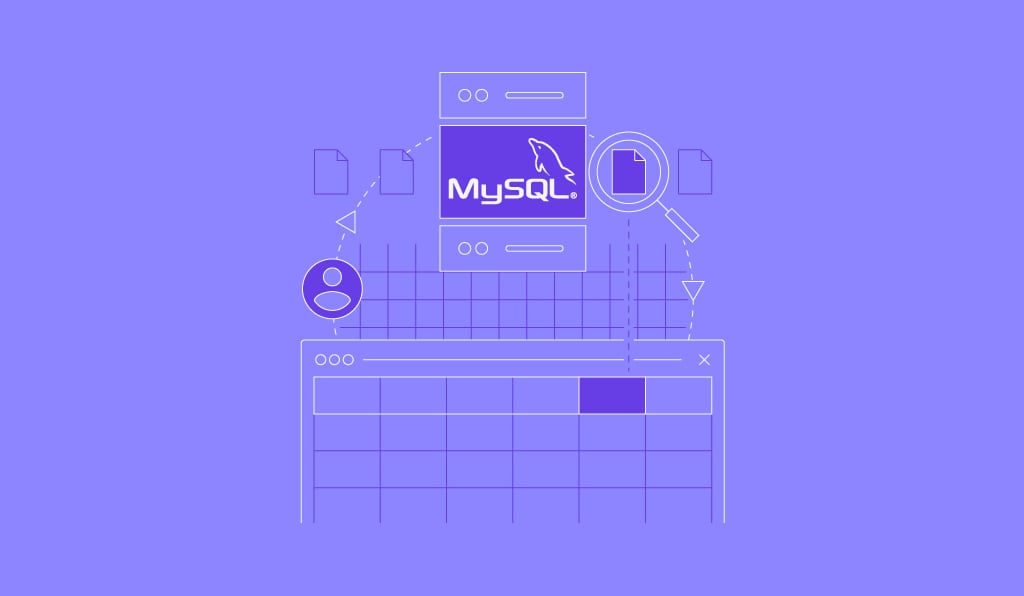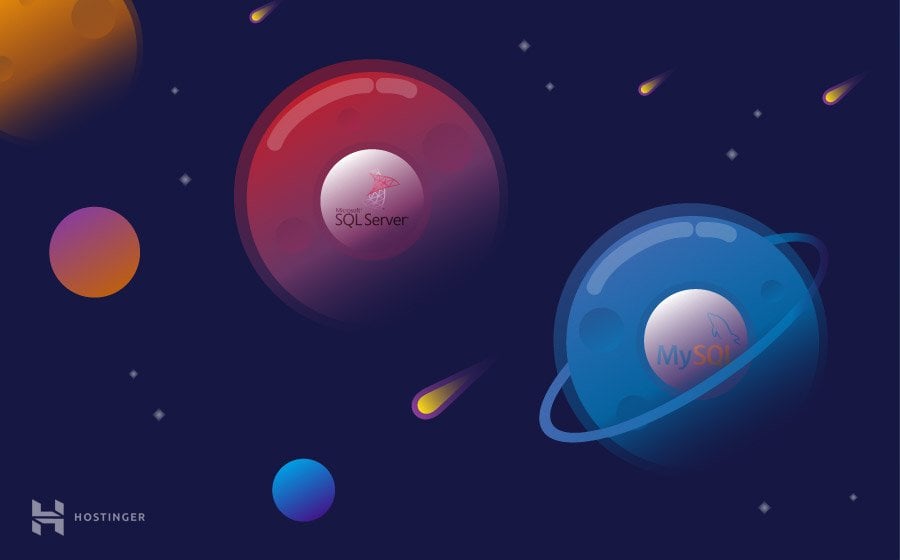What Is MySQL and How Does It Work

In today’s data-driven world, managing and accessing vast amounts of information efficiently is paramount for businesses and developers alike. This is where MySQL, an essential and widely-used relational database management system (RDBMS), comes into the picture.
For those new to the realm of databases and data management, MySQL might sound like a foreign term. In this comprehensive guide, we will explain what MySQL is and why it is such a critical tool in for data storage.

What Is MySQL – Video Tutorial
Learn what is MySQL, the most popular open-source relational database management system.

What is MySQL
MySQL is an open-source Relational Database Management System (RDBMS) that enables users to store, manage, and retrieve structured data efficiently. It is widely used for various applications, from small-scale projects to large-scale websites and enterprise-level solutions.
There are a few elements of MySQL. Let’s take a closer look at them:
Database
In relation to MySQL, a database is a structured collection of data organized and stored in tables. It serves as a central repository where information is efficiently managed, allowing users to store, retrieve, update, and delete data. MySQL provides the software framework to create, maintain, and interact with these databases, making data storage and retrieval seamless and reliable.
Client-Server Model
Computers that install and run RDBMS software are called clients. Whenever they need to access data, they connect to the RDBMS server.
MySQL is one of many RDBMS software options. RDBMS and MySQL are often thought to be the same because of MySQL’s popularity. A few big web applications like Facebook, Twitter, YouTube, Google, and Yahoo! all use MySQL for data storage purposes. Even though it was initially created for limited usage, it is now compatible with many important computing platforms like Linux, macOS, Microsoft Windows, and Ubuntu.
SQL
MySQL and SQL are not the same. Be aware that MySQL is one of the most popular RDBMS software’s brand names, which implements a client-server model.
The client and server use a domain-specific language – Structured Query Language (SQL) to communicate in an RDBMS environment. If you ever encounter other names that have SQL in them, like PostgreSQL and Microsoft SQL server, they are most likely brands which also use Structured Query Language syntax. RDBMS software is often written in other programming languages but always uses SQL as its primary language to interact with the database. MySQL itself is written in C and C++.
SQL tells the server what to do with the data. In this case, SQL statements can instruct the server to perform certain operations:
- Data query – requesting specific information from the existing database.
- Data manipulation – adding, deleting, changing, sorting, and other operations to modify the data, the values or the visuals.
- Data identity – defining data types, e.g. changing numerical data to integers. This also includes defining a schema or the relationship of each table in the database
- Data access control – providing security techniques to protect data. This includes deciding who can view or use any information stored in the database
Open-Source
Open-source means that you’re free to use and modify it. You can also learn and customize the source code to better accommodate your needs. However, The GPL (GNU Public License) determines what you can do depending on the conditions. The commercially licensed version is available if you need more flexible ownership and advanced support.

How Does MySQL Work?
The basic structure of the client-server structure involves one or more devices connected to a server through a specific network. Every client can make a request from the graphical user interface (GUI) on their screens, and the server will produce the desired output, as long as both ends understand the instruction. Without getting too technical, the main processes taking place in a MySQL environment are the same, which are:
- MySQL creates a database for storing and manipulating data, defining the relationship of each table.
- Clients can make requests by typing specific SQL statements on MySQL.
- The server application will respond with the requested information, and it will appear on the client’s side.
From the client’s side, they usually emphasize which MySQL GUI to use. The lighter and more user-friendly the GUI is, the faster and easier their data management activities will be.
Some of the most popular MySQL GUIs are MySQL WorkBench, SequelPro, DBVisualizer, and the Navicat DB Admin Tool. Some of them are free, while some are commercial, some run exclusively for macOS, and some are compatible with major operating systems. Clients should choose the GUI depending on their needs. For web database management, including a WordPress site, the most obvious go-to is phpMyAdmin.
Why is MySQL So Popular?
MySQL is indeed not the only RDBMS on the market, but it is one of the most popular ones. The fact that many major tech giants rely on it further solidifies the well-deserved position. Here are some of the reasons.
Flexible and Easy To Use
As open-source software, you can modify the source code to suit your need and don’t need to pay anything. It includes the option for upgrading to the advanced commercial version. The installation process is relatively simple, and shouldn’t take longer than 30 minutes.
High Performance
A wide array of cluster servers backs MySQL. Whether you are storing massive amounts of big eCommerce data or doing heavy business intelligence activities, MySQL can assist you smoothly with optimum speed.
An Industry Standard
Industries have been using MySQL for years, which means that there are abundant resources for skilled developers. MySQL users can expect rapid development of the software and freelance experts willing to work for a smaller wage if they ever need them.
Secure
Your data should be your primary concern when choosing the right RDBMS software. With its Access Privilege System and User Account Management, MySQL sets the security bar high. Host-based verification and password encryption are both available.
Conclusion
MySQL stands as a cornerstone in the ever-evolving landscape of data management. Its widespread adoption across diverse applications and its use by tech giants prove its versatility and reliability.
MySQL’s flexibility and user-friendliness are some of the reasons behind its popularity. Furthermore, its status as an industry standard has fostered a rich pool of resources and skilled developers, ensuring continuous development and ample support for users.
MySQL remains an invaluable tool for harnessing the potential of data with efficiency, performance, and security. Whether you are a novice or a seasoned data enthusiast, mastering MySQL opens doors to a world of data-driven possibilities, enabling you to stay ahead in this ever-evolving landscape of technology and business.
What Is MYSQL FAQ
What Does MySQL Mean?
MySQL is a relational database management system (often shortened to RDBMS). SQL is an abbreviation for Structured Query Language, and the prefix My is a reference to the co-founder’s daughter.
Is MySQL Software or Language?
MySQL is a database management system, not a programming language. MySQL uses structured query language (SQL) to manage data inside a database.
Is MySQL a Database?
MySQL is a tool used to manage databases and servers, so while it’s not a database, it’s widely used in relation to managing and organising data in databases.


Comments
December 08 2019
Thank you for this article. It helped me with my desire for general explanation. I' l be glad to read more like this
January 11 2020
Though am completely to the above technology and trying to catch up, so far am impress with Hostinger tutorial
December 03 2020
HI. I create a database with mysql and it works fine in a directory. I copy it and put it in another directory and I get this error: [FireDAC] [Phys] [MySQL] Unknown database '' c: \ resp_c \ demo \ hotpluss'. Why does the database not recognize me? Thank you.
February 09 2021
Hi there! I'd suggest to make sure that your database does not define a directory. If a directory is defined - make sure to change it in your database. You'd also need to make sure that your database credentials are well and the php file can connect to it.
March 16 2022
Super
January 05 2022
Super
January 26 2022
Super...it's helpful ✌️
January 30 2022
Thank you for this article ?
February 03 2022
Excellent article!!
March 10 2022
super
February 06 2022
Good explanation...
February 16 2022
Good
February 20 2022
Very good article sir .
March 02 2022
?
March 07 2022
Very good article sir
March 12 2022
Super
March 21 2022
Super
March 23 2022
Good
March 29 2022
This is great
April 01 2022
Good???
April 20 2022
Very good article sir
May 10 2022
Nice
October 27 2023
It is very important and use full
November 07 2023
Hi there! It's great to know you found the information valuable. If you ever need more guidance or have additional questions, please feel free to ask ?
October 27 2023
It is very important and useful for learning
October 31 2023
Hello! Let's learn together. If you have any suggestions, please don't hesitate to let us know ?